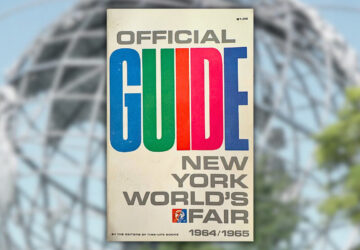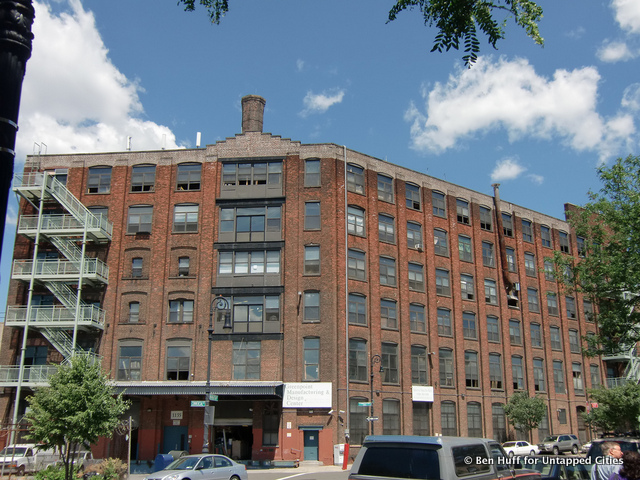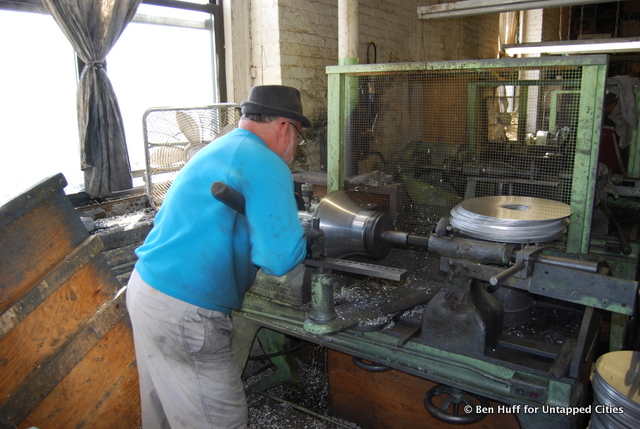In early 1905, some 4,000 people would wake in the morning in North Brooklyn and travel to work in the local factory buildings that manufactured rope. Today, Mark Davidson follows a similar routine but when he arrives at 1155 Manhattan Ave, better known as the home of Greenpoint Manufacturing and Design Center (GMDC) in North Brooklyn, he designs upscale jewelry destined for the showrooms of Barney’s in Midtown. For over 100 years, people have continuously traveled to this building at the tip of Greenpoint (the northern most point of Brooklyn) to make finished products from when the first building was completed to present day.
In the latter half of the 1800s, Greenpoint rapidly industrialized, taking control of a magnificent stretch of waterfront on the East River. Industrial buildings spread out all along the area to utilize piers and maritime transportation. 1155 Manhattan Avenue’s first building was built in 1868 by the Chelsea Fiber Mills company, occupying this critical point where Newtown Creek meets the East River. Chelsea Fiber Mills produced good quality marine rope, also known as a jute mill, which helped serve the shipyards that also called the East River waterfront home. As the Fiber Mills business grew, so did the amount of buildings until the complex in its current form of 8 connected buildings was completed in 1903. The complex was so large it had its own steam power generator, of which the smokestack still survives. Charles M. Pratt of Astral Oil (who later founded the Pratt Institute) was an early investor in the company. Pratt’s oil company later merged with John D. Rockefeller’s Standard Oil. This helped Rockefeller create a monopoly on the refinery market that was present on the creek, which along with other heavy industrial activities led to massive pollution. (Newtown Creek is now a superfund site.)
At 6 stories tall the building stands out among the small row houses that populate the rest of Manhattan Avenue. Its brick façade is in great condition, a testament to how well these factory buildings were built. The building received fiber directly from boats on Newtown Creek, and could then ship finished product out. Chelsea Fiber Mills played an important role in supplying rope for the U.S. Navy during World War I and II. In addition, it employed thousands of workers who would settle in the adjacent residential section of Greenpoint, making homes out of the railroad flats and row houses within walking distance.
Like much of the manufacturing sector in Brooklyn, after World War II the site saw serious decline. Chelsea began leasing space to a textile and dye company known as Grossen Dye Works. This ownership did not succeed in keeping the building financially secure enough to give proper maintenance, and it ended up under city ownership through a tax foreclosure in 1974. The city worked out deals with small manufacturers who began to repopulate the building, offering month by month leases, but were still unable to make enough money for maintenance. Plans floated around for demolishing the site, with the possibility to rebuild as a residential building; however these plans were also scrapped.
In the late 1980s, local activists and tenants of the building met with the North Brooklyn Economic Development Corporation to talk about organizing a group to assume ownership from the city. In 1992, that moment arrived and the city sold it to the newly formed GMDC for the price of a single dollar. The goal of GMDC would be two-fold: to include historic preservation of buildings and to keep rents affordable for industrial tenants. Never before had a model of a non-profit industrial developer existed to help protect space for small manufacturers. Since the city has sold the building to GMDC they have leveraged $8 million for rehabilitation of this site, while going on to rehabilitate three other industrial buildings in Brooklyn.
One of the people that has benefited greatly from the creation of GMDC is Fransico Useche. Fransico is one of the oldest tenants in the building from the uncertainty period of the 1970s. His metal spinning shop does all custom orders, and his work is beautiful. He showed me how he makes his finished product, taking a flat metal circle and placing it in his spinner, then using a tool to shape it in to a curved light fixture. His shop used to shape all the light holders for street lamps in Central and Prospect Park. Another reason Fransico has stayed for so long in this site–close to 80% of his products are sold in the metro area.
On the opposite side of the tenant spectrum is one of the newest in the building, Kayrock Screenprinting. Founded by Karl LaRocca in 1998, Kayrock does silk screening and graphic design work for local businesses. Their work can be seen all over Brooklyn, whether it’s the posters promoting upcoming concerts at the Music Hall of Williamsburg or t-shirts for the Brooklyn Brewery. They had been working for years in a building on Kent Avenue before developers had purchased it to build a high rise residential condo on it. Moving to 1155 Manhattan just 5 months ago helped Larocca stay in the North Brooklyn area where he can be close to his clientele and his home in Bushwick.
These are just a small example of the types of businesses that now occupy space in the building. Although GMDC is the main authority in the building, they really are just an umbrella group for the 70+ tenants and some 240 employees that occupy the spacious lofts throughout the complex. As you walk through the naturally lit halls, activity explodes around you as manufacturers, designers and craftsman hustle and bustle about.
Just as the community helped revive the 1155 Manhattan to begin with, the community again approached GMDC, this time for a boathouse project. Although more concerned with keeping the building up to code or modernizing the elevators, GMDC saw hope in this renovation project. The details are simple; using a mixture of funds GMDC will be able to rebuild the damaged stretch of bulkhead along Newtown Creek and use build out a section of their basement that is currently vacant. In order to open up the basement, they will conduct a historically appropriate restoration of this section of the facade and the windows. Winning the Partners in Preservation Challenge will help get them closer to achieving this goal.
Working with the North Brooklyn Boating Club they have helped set up an impressive open space plan, and although not required to follow the waterfront design guidelines, they have decided to do so. This will allow the public to have access to this small but magnificent stretch of waterfront with perfect views of the Midtown skyline. The renovated basement will be used for a small boat safety and skills training facility; environmental and educational displays; and storage for more than 60 kayaks, canoes and other small boats.
Although the aim of GMDC is historic preservation and supporting the manufacturing sector, they are not a group looking just to preserve “the way things were.” Building this boathouse project is a perfect example, they are able to merge their historic preservation goals while allowing public access to the Newtown Creek that it has not had since the early 1800s. GMDC will be able to increase their connection to the local community, support a good cause and respond to community input as they had in the past.
Click here to vote for the Greenpoint Manufacturing and Design Center, find out more about the Greenpoint Manufacturing and Design Center here and the North Brooklyn Boating Club here. Follow Untapped Cities on Twitter and Facebook.
Untapped Cities is an official blog ambassador for Partners in Preservation , a community-based initiative by American Express and the National Trust for Historic Preservation to raise awareness of the importance of historic places. Stay up-to-date with Untapped’s coverage of all 40 sites by following our Partners in Preservation category.

















